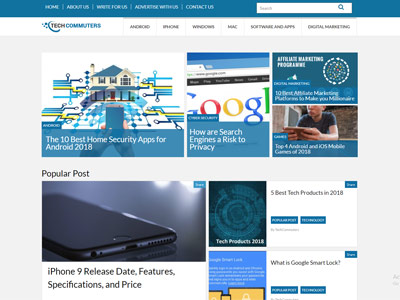Check Out Thought-Provoking Articles on the Best tech blog for Tech Lovers
Check Out Thought-Provoking Articles on the Best tech blog for Tech Lovers
Blog Article
Recognizing the Increase of Edge Computer in Today's Digital World
In the swiftly evolving landscape of innovation, side computer arises as a crucial force, improving how information is processed and used. By transitioning information administration closer to the resource, side computing addresses vital latency concerns while optimizing data transfer use and enhancing protection actions.
What Is Edge Computer
Edge computer, although a fairly recent innovation in the realm of technology, fundamentally transforms how data is processed and taken care of by bringing calculation and information storage space closer to the area where it is required. Unlike traditional cloud computer models, which frequently depend on centralized data facilities that can be geographically remote, side computer decentralizes information handling. This proximity decreases latency, enhances real-time information handling, and enhances the general customer experience by ensuring quicker response times.
At its core, edge computer includes a network of local tools and infrastructure, such as routers, sensing units, and gateways, efficient in processing data at or near the source. This local handling ability is specifically critical for applications calling for immediate information evaluation, such as independent vehicles, industrial automation, and wise cities. Furthermore, by unloading information processing tasks from central servers, edge computing minimizes data transfer requirements and improves information privacy and security, as delicate info can stay on-site as opposed to going across extensive networks.

Trick Motorists of Fostering
Several elements are propelling the fostering of edge computer in today's electronic landscape. Edge computing addresses this requirement by allowing information processing closer to the information source, reducing latency and improving real-time decision-making capacities.
One more significant driver is the need for boosted bandwidth efficiency. Central cloud systems can become overloaded with the large volume of information produced by IoT tools, bring about traffic jams (Best tech blog). By refining data at the side, companies can minimize network blockage and enhance general system performance
Additionally, protection and privacy worries are pushing organizations towards edge computer. By processing delicate data locally, companies can alleviate dangers related to data transmission and exposure to possible cyber hazards.
The rise of applications requiring real-time handling, such as independent cars and boosted reality, likewise necessitates the fast action times that edge calculating offers. Jointly, these motorists are making side computing an essential part of modern-day IT infrastructure, leading the way for its widespread fostering across various sectors.
Advantages Over Cloud Computer
Exactly how does edge computer distinguish itself from typical cloud computing? Largely, side computing brings information handling closer to the resource of data generation, typically on regional tools or neighboring servers, instead of relying upon centralized information centers. This closeness dramatically minimizes latency, making it possible for real-time information processing and decision-making. For industries where nanoseconds matter, such as autonomous lorries or industrial automation, the decreased latency given by side computer can be critical.
Additionally, edge computing enhances data transfer efficiency (Best tech blog). By refining information locally, just the necessary information is sent to the cloud for more evaluation or storage space, lowering the volume of data that goes across the network. This not only alleviates network blockage however additionally reduces information transmission expenses
Edge computing additionally provides better data privacy and protection. Delicate information can be processed in your area without being sent out to the cloud, decreasing the direct exposure to potential cyber risks. This is specifically valuable for industries managing secret information, such as healthcare and economic services.
Moreover, edge computer ensures higher strength and integrity. Local handling enables proceeded operation also when connectivity to the cloud is jeopardized, maintaining crucial features and solutions despite prospective network disturbances. These advantages jointly demonstrate side computer's transformative potential in enhancing efficiency and security in electronic communities.
Difficulties and Factors To Consider
While edge computing provides many benefits, it also presents special difficulties and factors to consider that have to be dealt with to totally understand its possibility. In addition, handling and keeping an eye on a decentralized click here for more network of edge gadgets can be complicated, needing innovative devices and techniques to guarantee seamless operation and maintenance. Best tech blog.
An additional consideration is the scalability of edge computer services. As the number of connected devices expands, so does the demand for processing power at the side, which can result in resource restraints. Organizations needs to carefully prepare their infrastructure to accommodate this development without endangering efficiency or effectiveness.
Interoperability is one more important aspect. With different hardware and software parts included, guaranteeing compatibility and seamless assimilation can be difficult. Standardization initiatives are essential to assist in communication between disparate systems.
Future Fads in Edge Computing
Preparing for the future, side computing is poised to revolutionize different sectors by allowing faster data handling and lowering latency. As the volume of information produced by IoT tools remains to grow, side computer will certainly end up being significantly important in handling this increase effectively. One substantial pattern is the combination of click to investigate fabricated knowledge at the side, permitting real-time analytics and decision-making without counting on cloud-based resources. This shift is expected to boost applications in self-governing vehicles, wise cities, and medical care, where prompt information processing is crucial.
One more arising fad is the growth of edge-native applications made particularly to leverage the distinct capabilities of edge computing. These applications will enhance performance and resource use, causing increased efficiency across different sectors. Developments in 5G innovation will even more bolster edge computer by supplying the necessary framework for high-speed, low-latency communication between devices and side nodes.
Verdict
Side computer's surge is driven by the expansion of IoT gadgets and the need for real-time information processing, which boosts effectiveness by decreasing latency and decentralizing data administration. This approach mitigates bandwidth inadequacies and protection problems, assisting in developments in applications like wise cities and autonomous automobiles. In spite of obstacles such as framework complexity and assimilation, the future of side computing promises an extra responsive electronic ecosystem, with continued innovations shaping its evolution and increasing its applicability throughout industries.
Edge computing, although a relatively recent development in the world of modern technology, fundamentally transforms just how information is refined and taken care of by bringing computation and data storage space closer to the area where it is needed. Unlike typical cloud computing models, which frequently depend on central data facilities that can be geographically remote, edge computing decentralizes data handling. Furthermore, by offloading data handling jobs from main servers, side computing minimizes bandwidth demands and enhances data personal privacy and safety and security, as delicate information can stay on-site instead than passing through considerable networks.

Report this page